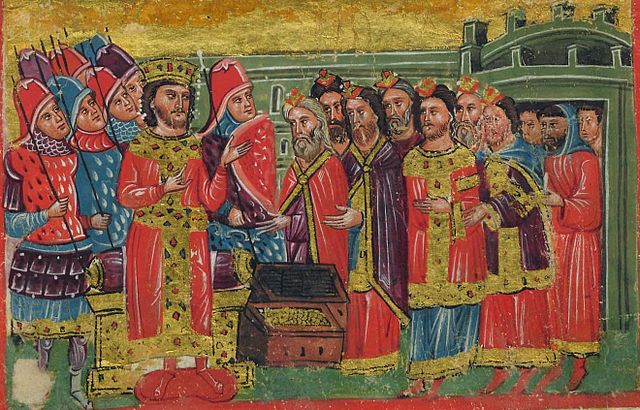
Alexander the Great, clad as a Byzantine emperor, receives a delegation of Jewish rabbis. Miniature from the 14th-century Alexander Romance | (c) en.wikipedia.org/wiki/History_of_the_Jews_in_the_Byzantine_Empire
Today, we will be exploring the topic of Jews under Byzantine rule. The Byzantine Empire was a powerful state that controlled much of the eastern Mediterranean for over a thousand years. During this time, Jews lived in various regions under Byzantine control, including Egypt, Syria, and Palestine. We will discuss the development of the Jewish diaspora in the first century.
If you want to expand your understanding of our shared history, join us on a glatt kosher cruise, with Kosher River Cruises. Travel in style, experience fine kosher dining, and participate in daily services onboard. See and discover fabulous destinations whilst staying in luxury onboard one of the best Jewish cruises in the world. This is your chance to experience a Jewish vacation over and above the norm.
Jews and Christians in The Roman Empire
The Roman Empire spans from a large area of land. Jews have been recorded throughout the 1st-3rd centuries to be living in areas like Byzantium, Constantinople, Mesopotamia, North Africa, Iberian Peninsula, Italian Peninsula, and so much more. Though there are some areas where there is a large concentration of Jews, some places also have maybe three or less families. Nonetheless, Jews are scattered throughout most of the territories of the Roman Empire. At the same time, there are also Jewish areas that have strong Christian communities mixed with them. For the first couple of centuries, Christian and Jewish communities usually overlapped one another.
During St. Paul of Tarsus’ great tours to the Mediterranean, he would usually visit Jewish sites since this is where he would find Jews or non-Jews to convert. Especially non-Jews who are attracted to the synagogue but are maybe a bit hesitant because of the extreme requirements of conversion like circumcision. This would be his ideal audience to find whenever he is traveling around. This can show you the massive spread of Jews all over the Roman Empire. Later on, the Babylonian Talmud and Jerusalem Talmud would play a huge role in maintaining connection with these contrasting communities. It became kind of like a standardized constitution that Jews could look at outside of the Bible. The Talmud became the sanctioned Jewish interpretive tradition that would dictate how the Jewish population of the Mediterranean basin would behave.
Edict of Milan
During the year 313, massive changes began to emerge. The Edict of Milan, a decree by the Roman Emperor, put a halt on the persecution of Christians. Jews were also now essentially eligible to reach citizenship. More importantly, Judaism was also considered to be a legitimate religion. This was referred to as “Religio Licita,” or the special status of the Jewish population in the Roman Empire. For example, Jews would be exempted from official emperor worship since they have their own religion that would prohibit these basic civic duties. On the other hand, Christians were not recognized the same way as Jews. During the 2nd century, they were often criticized and exposed to tremendous persecution for not worshiping the Emperor. Due to this, they were also given an exemption by the Edict of Milan. This created a parity between the Christians and the Jews. Ultimately, Christians would have far more power as Christianity becomes the official state religion, putting Jews at a disadvantage.
